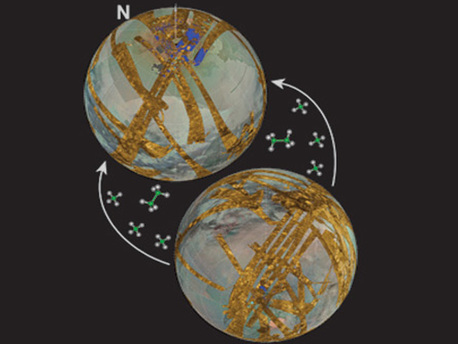Mystery Solved
The New Theory
 © NASA/JPL/Caltech/UA/SSI |
The northern and southern hemispheres of Titan, showing the great disparity between the abundance of lakes in the north and their paucity in the south. The hypothesis presented favors long-term flux of volatile hydrocarbons, predominantly methane, from hemisphere to hemisphere. Recently, the direction of transport has been from south to north, but the effect would have reversed tens of thousands of years ago
Like Earth and other planets, Saturn's orbit is not perfectly circular, but is instead somewhat elliptical and oblique. Because of this, during its southern summer, Titan is about 12 percent closer to the sun than during the northern summer. As a result, northern summers are long and subdued; southern summers are short and intense.
"We propose that, in this orbital configuration, the difference between evaporation and precipitation is not equal in opposite seasons, which means there is a net transport of methane from south to north," said Aharonson. This imbalance would lead to an accumulation of methane and hence the formation of many more lakes in the northern hemisphere.
This situation is only true right now, however. Over very long time scales of tens of thousands of years, Saturn's orbital parameters vary, at times causing Titan to be closer to the sun during its northern summer and farther away in southern summers, and producing a reverse in the net transport of methane. This should lead to a buildup of hydrocarbon - and an abundance of lakes - in the southern hemisphere.
"Like Earth, Titan has tens-of-thousands-of-year variations in climate driven by orbital motions," Aharonson said. On Earth, these variations, known as Milankovitch cycles, are linked to changes in solar radiation, which affect global redistribution of water in the form of glaciers, and are believed to be responsible for ice-age cycles. "On Titan, there are long-term climate cycles in the global movement of methane that make lakes and carve lake basins. In both cases we find a record of the process embedded in the geology," he added.
"We may have found an example of long-term climate change, analogous to Milankovitch climate cycles on Earth, on another object in the solar system," he said.
Source: NASA/JPL
Mystery Solved
The New Theory
 © NASA/JPL/Caltech/UA/SSI |
The northern and southern hemispheres of Titan, showing the great disparity between the abundance of lakes in the north and their paucity in the south. The hypothesis presented favors long-term flux of volatile hydrocarbons, predominantly methane, from hemisphere to hemisphere. Recently, the direction of transport has been from south to north, but the effect would have reversed tens of thousands of years ago
Like Earth and other planets, Saturn's orbit is not perfectly circular, but is instead somewhat elliptical and oblique. Because of this, during its southern summer, Titan is about 12 percent closer to the sun than during the northern summer. As a result, northern summers are long and subdued; southern summers are short and intense.
"We propose that, in this orbital configuration, the difference between evaporation and precipitation is not equal in opposite seasons, which means there is a net transport of methane from south to north," said Aharonson. This imbalance would lead to an accumulation of methane and hence the formation of many more lakes in the northern hemisphere.
This situation is only true right now, however. Over very long time scales of tens of thousands of years, Saturn's orbital parameters vary, at times causing Titan to be closer to the sun during its northern summer and farther away in southern summers, and producing a reverse in the net transport of methane. This should lead to a buildup of hydrocarbon - and an abundance of lakes - in the southern hemisphere.
"Like Earth, Titan has tens-of-thousands-of-year variations in climate driven by orbital motions," Aharonson said. On Earth, these variations, known as Milankovitch cycles, are linked to changes in solar radiation, which affect global redistribution of water in the form of glaciers, and are believed to be responsible for ice-age cycles. "On Titan, there are long-term climate cycles in the global movement of methane that make lakes and carve lake basins. In both cases we find a record of the process embedded in the geology," he added.
"We may have found an example of long-term climate change, analogous to Milankovitch climate cycles on Earth, on another object in the solar system," he said.
Source: NASA/JPL





